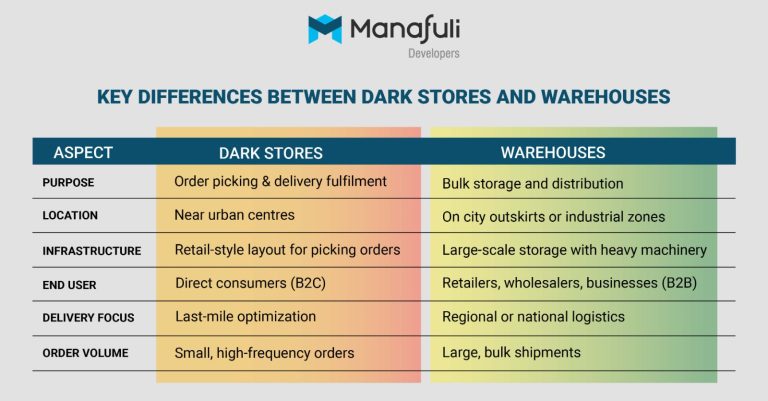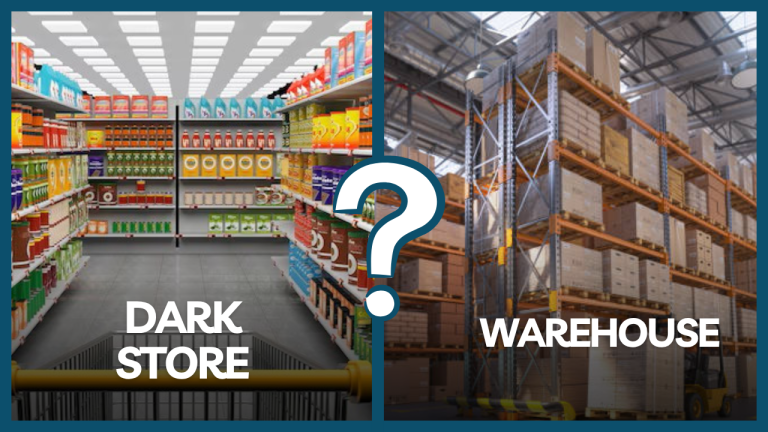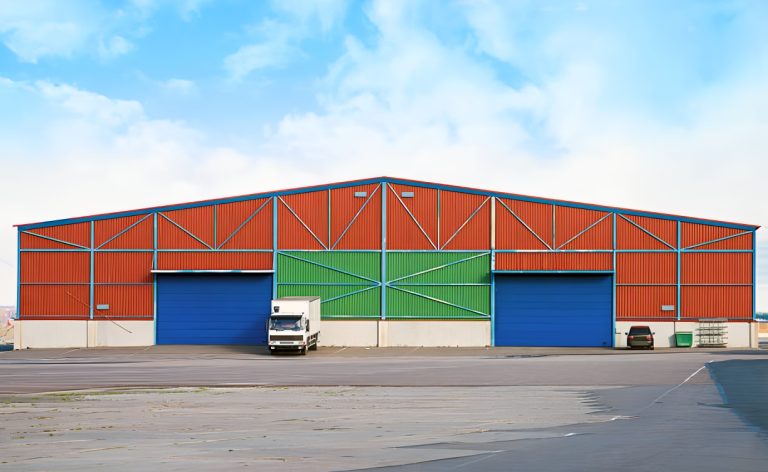The Difference Between Dark Stores and Warehouses
In the evolving landscape of retail and logistics, understanding the functional differences between dark stores and warehousing is essential for business leaders, investors, and logistics planners. Both models have distinct roles in the supply chain, and each is gaining importance in the digital economy.
As demand for faster deliveries and efficient inventory management rises, dark stores and warehouses are becoming strategic assets. More effective when located within industrial parks that offer infrastructure aligned with modern operational needs.

Defining Dark Stores
Dark stores are retail distribution centres that are closed to the public. Although they resemble traditional supermarkets or retail stores in structure, they are used solely to fulfil online orders.
Their primary advantages include:
- Faster order processing
- Controlled inventory management
- Enhanced delivery coordination
- Proximity to consumer clusters
These features make dark stores a revolutionary model in e-commerce logistics. Manafuli Industrial Park Pailan, situated near D.H. Road, offer industrial plots that are ideal for placing last-mile stores for quick commerce. The proximity to residential areas makes this project an attractive opportunity. Sectors such as groceries, pharmaceuticals, and fast-moving consumer goods (FMCG), where timely delivery is essential, can particularly benefit from these plots.
Understanding Warehousing
Warehousing refers to the large-scale storage of goods before distribution. Warehouses are typically situated in industrial zones, designed to accommodate high volumes of inventory over extended periods.
Today’s warehouses are increasingly automated, equipped with digital inventory systems, robotics, and data analytics for efficient space utilization and movement tracking. For example, Magna Star Industrial Parks will install AI-powered monitoring devices to track truck weights. These devices will also enhance security within the premises.
There are various types of warehouses:
- Centralized warehouses for managing national inventory,
- Decentralized warehouses for regional fulfilment,
- 3PL (third-party logistics) warehouses that manage logistics on behalf of multiple clients,
- And specialised fulfilment centres, such as those operated by Amazon, which combine storage and delivery functions.
These facilities are designed with bulk storage, inventory management systems, and shipping docks to handle high-volume operations effectively.
Both models are not mutually exclusive; rather, they complement each other in integrated supply chain networks.

Which One Should You Choose?
The decision between dark stores and warehousing depends heavily on your business goals, product type, and delivery timelines.
- Dark stores are perfect for high-velocity items that need to reach urban consumers fast—think perishables, household essentials, and healthcare items.
- Warehousing is better suited for stable, non-perishable goods where shipping time is less critical but volume is high, like electronics, apparel, or home goods.
Misconception Around the Two
Myths always follow trends that lead to confusion. Here’s a look at the most common disinformation and the current reality:
- FDI Violation Claims:
Platforms like Blinkit and Zepto are said to breach FDI rules by controlling inventory.
Reality: No confirmed violation; regulatory review is still ongoing. - Food Safety Concerns:
Claims suggest unhygienic handling and near-expiry goods in dark stores.
Reality: FSSAI has increased surprise audits; platforms are delisting non-compliant sellers and improving checks. - Cybersecurity in Warehouses:
It’s assumed that warehouses are highly vulnerable to data breaches.
Reality: Risks exist, but many operators are implementing layered cybersecurity measures. - Job Loss Due to Automation:
Automation is seen as replacing human labour.
Reality: It’s shifting job roles, not eliminating them. Reskilling is key.
Industrial parks, like Magna Star and Manafuli Industrial Park Pailan, also help address these issues through better compliance, security, and ethical practices.

Future Trends
Looking ahead, several trends are shaping the evolution of these fulfilment models:
- Micro-fulfilment centres are emerging as a bridge between dark stores and warehouses, offering fast service from compact, automated hubs.
- AI and robotics are revolutionising picking, packing, and routing in both models, improving accuracy and reducing labour costs.
- Sustainability is becoming a priority, with efforts to reduce carbon emissions and energy use, especially in warehousing via integration into sustainable industrial parks. These parks offer space, infrastructure, and compliance for eco-conscious warehousing and fulfilment operations.
- Consumer expectations continue to push the envelope, demanding faster, more reliable, and more eco-conscious deliveries.
Conclusion
Dark stores and warehousing represent two distinct yet interlinked components of the modern supply chain. While dark stores enable quick, local fulfilment, warehouses support the backbone of long-range storage and distribution.
For business leaders, developers, and those planning to invest in land, understanding these models is crucial. Avoid misconceptions, assess needs objectively, and align your strategy with the evolving logistics ecosystem. The opportunities are substantial, and with the right approach, also highly rewarding.


